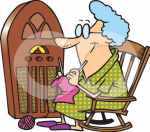1920s - RECEIVER DEVELOPMENT
Receivers in the mid
20’s were of course battery operated, with an A, B, and C battery. The
tuning range varied, and covered what would later become the mediumwave and shortwave bands. The superhet had not as yet been
invented and neither had the tetrode or pentode valves.
Directly heated valves were used, generally in two stage sets
– one regenerative detector followed by an audio output stage. More pretentious sets accommodated several RF amplifier
stages, followed by a detector and one or more audio amplifier stages The ganged variable capacitor had not yet been invented,
and single gang tuning capacitors were all brought out to separate front panel controls, each requiring to be lined up manually.
Receivers were invariably regenerative types – howls and squeals were the order things due to their inherent radiation
capabilities.
Some receivers were very elaborate indeed, with luxurious panelled cabinets,
One model “ advertised as a "Udisco -6” covered all frequencies from 750 kHz up to 15 MHz Receivers of those days
were regarded as part of the furniture
Prices quoted for this particular model were around £100, complete with stand,
speaker, batteries, valves, and antenna. That sort of price was a lot of money in those days!
Radio magazines proliferated, and emphasised the home construction craze of the
1920's. Technical editors published constructional details of receivers, which was followed by the release of kits of parts
by commercial dealers. There were innumerable radio displays and exhibitions.
Band changing was generally by plug in coils - some advanced sets featured mechanical
shortwave switching features.
Battery operated sets continued until about l928, when the first of the battery
eliminators appeared, due to the introduction of grid electricity. The first “all-electric" set appeared towards the
end of the 1920's, and with it the first of the indirectly heated valves - cumbersome batteries started to phase down, but
they would continue to be used for many years by hobbyists who could not afford
the latest all-electric radios.
During the 1930s, technological advances saw the invention of the tetrode and
pentode valves, and the introduction of the superheterodyne receiver concept. By the start of WW2, most households had at
least one superhet radio, occupying pride of place in the main room of the home.
Antenna systems in the l920s were generally consisted of long wires. The longer
and higher the wire, the greater the signal pickup. Elaborate insulation properties were introduced for feeding the antenna
to the receiver. Emphasis was also placed on good earthing systems, which were a carryover from the crystal set days, it was
not until the advent of the superhet that the large antenna systems started to decline, due to the increased

